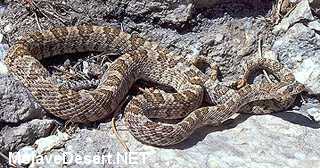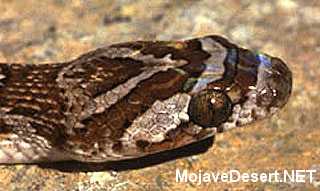Western Lyre Snake
Trimorphodon biscutatusFamily: Colubridae Order: Squamata Class: Reptilia
DISTRIBUTION, ABUNDANCE, AND SEASONALITY
The Iyre snake is found on rocky slopes, in canyons, on mesas and in boulder piles up to
elevations of 910 m (3000 ft). It is restricted to the mountains and canyons of coastal
southern California, to scattered desert mountain ranges, and along the southeastern border
of the state in less mountainous areas, where it seems more tolerant of desert flats and
plains. It is a secretive animal and may have a wider and more extensive range in the desert
than is presently known (Klauber 1940, Stebbins 1954). Because it occurs in mostly rocky
areas and is secretive, little information is available on abundance. It is never found in great
numbers (Stebbins 1954)
SPECIFIC HABITAT REQUIREMENTS
Feeding: Lyre snakes forage in rocky areas on small vertebrates also living among the
rocks. They eat bats, small rodents, lizards (Uta stansburiana and Xantusia henshawi) and
probably ground-nesting birds (Cowles and Bogert 1935, Klauber 1940, Stager 1942,
Krutzsch 1944). These snakes are venomous but presumably not dangerous to man. The
venom is hemolytic, attacking the red blood cells of the prey, reducing its ability to take
oxygen to tissues. Envenomation is by a pair of grooved teeth in the back of the mouth and a
pair of venom glands. The prey must be grasped in the mouth and chewed to get the venom
into the body (Stebbins 1954).
Cover: This snake prefers rocky cover. It can be found under granite flakes and slabs but
seems to prefer more secure cover. The widely used practice of prying up granite flakes by
amateur and professional collectors for the pet industry has destroyed a great deal of habitat
and represents a threat to this species (Stebbins 1954).
Reproduction: Eggs are probably laid deep under rock cover, and thus extensive rock
cover may be a requirement, but there are no data.
Water: Permanent water probably is not required.
Pattern: This species inhabits hilly, mountainous and canyon areas dominated by rocks.
It is rarely found very far from rocky areas, except in the eastern part of the state where it is a
little more tolerant of desert flats (Stebbins 1954).
SPECIES LIFE HISTORY
Activity Patterns: This species is nocturnal, foraging at night and occasionally in the early
morning (Stebbins 1954). It has been observed active every month of the year but
November, with a peak of activity in April and May (Klauber 1940, Stebbins 1954). Snakes in
the warmer southern part of the state will probably be active longer and earlier in the season
than in the north.
Seasonal Movements/Migration: None.
Home Range: No data. This species probably stays fairly close to rocky areas.
Territory: No data.
Reproduction: Lyre snakes lay eggs. One clutch was laid in the lab in September and
required 79 days to incubate (Stebbins 1954). A brood was found recently
hatched on October 1 (Cowles and Bogert 1935).
Niche: Lyre snakes are probably eaten by kingsnakes and other ophiophagous snakes,
avian predators (roadrunners and perhaps owls) and mammalian predators. Nothing is
known about disease, competition, or parasites. The Iyre snake may be an important
predator on crevice-nesting bats (Krutzsch 1944).
Also See:
Joshua Tree National Park Wildlife
California Lyre Snake Trimorphodon biscutatus vandenburghi Rocky foothills, canyons, and mesas (common) Western Diamondback Snake Crotalus atrox ...
Death Valley Snakes
California Lyre Snake Trimorphodon biscatatus vandenburghi Nocturnal; rocky areas; sea level to over 4000 ft. Desert Night Snake Hysiglena torquata ...
REFERENCES
Cowles, R. B., and C. M. Bogert. 1935. Observations on the California lyre snake, Trimorphodon vandenburghi Klauber, with notes on the effectiveness of its venom. Copeia 1935:80-85.
Klauber, L. M. 1940. The worm snakes of the genus Leptotyphlops in the United States and northern Mexico. Trans. San Diego Soc. Nat. Hist. 9:195-214.
Krutzsch, P. H. 1944. California lyre snake feeding on the pocketed bat. J. Mammal. 23:92.
Scott, N. J., and R. W. McDiarmid. 1984. Trimorphodon biscutatus. Cat. Am. Amphibians and Reptiles 353.
Stager, K. E. 1942. The cave bat as the food of the California lyre snake, J. Mammal. 23:92.
Stebbins, R. C. 1954. Amphibians and reptiles of western North America. McGraw-Hill, New York. 536pp., E. H. 1936. Notes and comments on certain American and Mexican snakes of the genus Tantilla, with Descriptions of new species. Trans. Kans. Acad. Sci. 39:335-348.
EXTERNAL LINKS
Discover Life - Colubridae: Trimorphodon biscutatus Cope, 1886
...Sonoran lyre snake, Baja california lyre snake, Texas lyre snake, Western lyresnake ... Trimorphodon biscutatus vandenburghi - California Lyre Snake ...
Friends of Saguaro National Park
About Saguaro National Park ... S. California east to Big Bend region of Texas, south to Costa Rica. ... Lyre snakes have fangs in the rear of the mouth that inject a mild venom into prey. ...
California Snakes
T. b. lyrophanes - Baja California Lyresnake, T. biscutatus - Western Lyre Snake, T. b. lyrophanes - Baja California Lyre Snake. Hydrophiidae - Sea Snakes ...
Southern California Herps
Tantilla planiceps - California Black-headed Snake Tantilla hobartsmithi - Southwestern Black-headed Snake Trimorphodon biscutatus - Lyre Snake ...
Snakes Around Las Vegas
California Lyre Snake Lyre Snake, Trimorphodon biscutatus lambda Trimorphodon biscutatus vandenburghi Trimorphodon biscutatus. Sidewinder (Crotalus cerastes ...
CNAH
Baja California Lyre Snake Trimorphodon biscutatus lyrophanes Cope, 1860. Taxonomic Comments:. Grismer et al. (1994 Bulletin of the Southern California ...
SDNHM - Taxa Described by L.M.Klauber
Herpetology Department · Research Library Archives. Taxa Described by Laurence M. Klauber. Trimorphodon vandenburghi Klauber (1924) -- California Lyre Snake ...
California Wild Spring 2000 - Striking Beauties
The night snake and lyre snake of southern California are two of the venomous colubrids, but neither poses a threat to people. ...
Natural History of the White-Inyo Range
Observations on the California lyre snake, Trimorphodon vandenburghi Klauber, with notes on the effectiveness of its venom. Copeia 1935:80–85. ...
Snakes of the Santa Monica Mountains, California
Trimorphodon biscutatus vandenburghi, California Lyre Snake. Rarely seen in the Santa Monica Mountains. They are nocturnal crevice-dwellers that exist in ...
 Western Lyre Snake
Western Lyre SnakePhoto by Chris Brown
 Western Lyre Snake
Western Lyre SnakePhoto by Chris Brown
Additional information:
Size: 17.7-35.4 in (45-90 cm)
Distinguishing characters: A slender species with a laterally flattened body; broad head, slender neck; V-shaped marking on top of head resembling lyre; light brown or grey on dorsal side with brown blotches; blotches roughly hexagonal and bisected with a pale crossbar; cream or white venter with pale brown spots; smooth scales; large, protruding eyes with vertical pupils.
Juveniles: Similar to adults in pattern, but highly contrasting in dorsal color; hatchlings can appear nearly black and white.
Dimorphism: Female is larger than male with extremely constricted tail; male's tail thickened midway between anal scale and tip, and is longer than that of a female's.
Similar species: Hypsiglena torquata: Has dark blotches on neck; dark bar across head; head less distinct from neck; lacks V-shaped markings on top of head.
Additional notes: A nervous species that hisses and vibrates rattleless tail when annoyed. Nocturnal and secretive, in our area it is usually associated with rocky hillsides and outcrops.